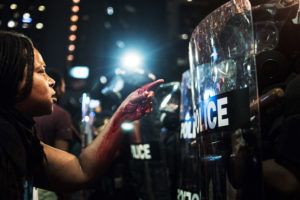It was the kind of correction you love to see. The story that originally broke in the final days of August, about a young black athlete being racially heckled in front of a crowd of thousands at Utah’s Brigham Young University, was not just exaggerated but completely false. The n-word was not shouted, let alone repeatedly, at Duke volleyball player Rachel Richardson when she went up to serve. A crowd of more than 5,000 people did not stand idly by during an act of malignant racism. The United States is not, apparently, a socially backwards hellscape where people openly scream slurs at packed sporting events without compunction or shame.
Unfortunately, it’s a correction that many people are probably never going to see — or if they do, they won’t believe it.
Like many stories of its oeuvre, this one began on Twitter, when Richardson’s godmother Lesa Pamplin claimed in a series of since-deleted posts that the young volleyball player had been subject to racist abuse throughout the game: “My Goddaughter is the only black starter for Dukes [sic] volleyball team,” she wrote. “While playing yesterday, she was called a [n-word] every time she served. She was threatened by a white male that told her to watch her back going to the team bus. A police officer had to be put by their bench.”
Pamplin hadn’t been at the game herself, but the claim was incendiary. The story was soon picked up by mainstream outlets, which treated the alleged harassment — and discovery of its perpetrator — as verified fact. From USA Today: “Brigham Young fan banned after directing racial slurs toward Duke volleyball player.” The Washington Post: “BYU bans fan, relocates volleyball match after racist slurs, threats.” The New York Times: “Racial Slur During College Volleyball Game Leads to Fan Suspension.”
Additionally, readers were warned that failing to believe this story, or even asking questions about it, was simply not an option. An op-ed from USA Today columnist Mike Freeman declared any doubts about Richardson’s veracity to be a “Right-wing conspiracy theory”, like QAnon or Pizzagate or 9/11 trutherism. Ditto the suggestion that she might have made a mistake: “The other conspiracy theory is that she misheard the word. That is a word you don’t mishear. You certainly don’t mishear it more than once.”
And yet, despite Freeman’s insistence to the contrary, not only is this a word that people do mishear, it has been only a year since the last high-profile incident in which someone misheard it in a similar context: in a raucous crowd at a sporting event, and, yes, more than once. In this case, the culprit was a man trying to get the attention of the Rockies mascot, whose name is “Dinger.”
That Richardson mistook another word for that word seems more likely than the alternative: that she fabricated the whole thing. But either way, it didn’t happen — and a responsible media class should never have reported otherwise so confidently, so soon. At the time, nobody present at the game had corroborated Richardson’s allegations, despite pleas from BYU’s athletic director for anyone who’d witnessed the incident to come forward. BYU and Duke athletic officials moved into the stands after the first alleged shout, but neither saw nor heard anything amiss. A review of video and audio footage also turned up nothing, and while the fan who was originally identified and permanently banned from BYU games was found in the footage, he wasn’t shouting slurs; he was sitting and playing with his phone. (BYU has unbanned him and apologised for the error.)
One potential solution to this problem, perhaps, would be a moratorium on teams with names or mascots ending in “-ger” (the BYU team is called The Cougars). Another would be to assume that in the year 2022, a person screaming something indecipherable in front of a crowd of thousands is in all likelihood not shouting a racial slur.
That is not to say that racism in American society has ceased to exist; on a systemic level, disparities continue, and the country still has work to do to level the playing field. But on an interpersonal one, America has never been less racist than it is today. A good proxy for how Americans feel about diversity on this front is the approval rating for interracial marriage, which was just 4% when the question was first polled in 1958. Last year, that number was 94%.
And the brand of racism that involves using the n-word, let alone in public, let alone in front of thousands of people, is simply (and happily) not an accepted part of our social landscape — as evidenced by the immediate mass condemnation and punishment of anyone even alleged to have indulged in it. Not only can we safely assume that most people feel no yearning to shout racial slurs at sporting events, we might also assume that the handful of troglodytes who do will nevertheless have the good sense to to avoid indulging that urge, given the consequences.
It’s a riff on the old medical wisdom: when you hear hoofbeats, think horses, not zebras. And when you hear a word with a hard “-ger” sound being shouted in the BYU stands, think cougars, not, well, you know.
But in our present moment, thinking “zebras” is what everyone does, and it’s not hard to understand why. Within the past few years, it seems like the folks who drive the national discourse — the cable news hosts, the talking heads, the journalists on every beat — have all coalesced around the narrative that when it comes to race in America, things are worse than ever.
The story goes like this: underneath the veneer of polite American society lies a deep and roiling river of racial resentment, barely contained at the best of times and always on the verge of spilling over. According to this narrative, that resentment is the only logical cause of every toxic, awkward, or otherwise negative interaction between a white person and a non-white person. Asking where someone is from? Racist. Working-class economic anxiety? Racist. Being unfriendly? Racist, obviously, but then again, so is being too friendly.
The idea that American race relations are bad and getting worse has been fuelled in many cases by legitimate tragedies: the killing of 18-year-old Michael Brown by police in Ferguson, Missouri, in 2014; the murder of George Floyd in 2020. But rather than seeing something like Floyd’s death as a problem of police abuse, and one that might be solved by police reform, we were told that it was representative of the country’s true character. When Derek Chauvin put his knee on Floyd’s neck, he was only making manifest the racist hatred that simmers inside all of us.
And if you assume the ubiquitous presence of that kind of hate, then no alleged hate crime, no matter how over-the-top, is too outlandish to be believed — even if the allegations themselves are unsubstantiated or ambiguous. The hoofbeats you hear? Zebras, not horses. When Jussie Smollett claimed to have been assaulted on the street at 3am, in one of the most liberal cities in the country, on one of the coldest nights of the year, by two Trump voters who just happened to be carrying a noose in their back pockets, it was interpreted as a sign how bad things really were. When a sixth grader alleged that she’d been pinned down and had her dreadlocks forcibly cut by three white classmates, it was the same. When a journalist accidentally said “Nakers” (a spoonerism of “Knicks” and “Lakers”) while reporting on the death of Kobe Bryant, the internet went wild: obviously this was a pathetic attempt to get away with saying the n-word, as we had been reliably assured all white Americans are constantly yearning to do. When a 15 year-old in a MAGA hat smiled awkwardly at the guy chanting and banging a drum in his face, we knew we were witnessing an act of racial aggression. And when a looped string appeared — in a public park, or in a NASCAR garage — we knew, without a doubt, that it was a noose.
This is what happens to a society that has been primed to assume the worst — and then, when the worst turns out not to be the case, to simply point to the assumption itself as evidence that things are dire. When the “noose” hung in NASCAR driver Bubba Wallace’s garage turned out to be just a pull rope, the Washington Post scolded readers that this was no reason to feel relieved: being glad that this wasn’t a hate crime just indicated a state of “denial about the dreary state of the nation”. Don’t you dare imagine that things are getting better. Don’t you dare imagine progress has been made. Maybe this cry of “wolf!” turned out to be baloney, but the fact that you believed there was a wolf tells you everything you need to know.
Needless to say, it is not good for a society to exist in a state of such constant catastrophising vigilance for signs of racial resentment. Amid our obsessive fear of fake news, this is a particularly insidious sort of misinformation; it is the reason why, for instance, liberal Americans grossly overestimate the number of unarmed black men killed every year by police. The actual number in 2019 was somewhere between 10 and 30, but fully 53% of surveyed liberals assumed it was over 1,000, while 22% estimated the number at 10,000 or more. It is also why, even as Americans across the board report feeling good about diversity and warmth for their black countrymen, we nevertheless believe that other people’s racism is bad and getting worse.
But the worst harm is something more basic: it is bad for black Americans to be unreasonably terrified that they’ll be hate-crimed every time they leave the house. It is wrong to instil fear and pessimism and panic for the sake of clicks. And telling people that many of their fellow Americans secretly hate them and wish them harm, when this is not in fact the case, is morally reprehensible.
Disclaimer
Some of the posts we share are controversial and we do not necessarily agree with them in the whole extend. Sometimes we agree with the content or part of it but we do not agree with the narration or language. Nevertheless we find them somehow interesting, valuable and/or informative or we share them, because we strongly believe in freedom of speech, free press and journalism. We strongly encourage you to have a critical approach to all the content, do your own research and analysis to build your own opinion.
We would be glad to have your feedback.
Source: UnHerd Read the original article here: https://unherd.com/




